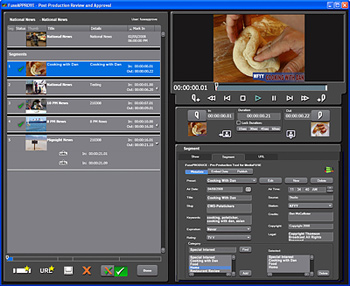Managing Media for Broadcast and Beyond
SAN FRANCISCO
The first batch of asset management technologies set out to accomplish a lofty goal: to simultaneously keep close tabs on thousands of hours of broadcast material, and at a moment's notice, allow an editor to snag a specific clip from a specific scene and prep it for air.
And as broadcaster's needs have changed in the last several years, today's digital asset management systems have had to evolve as well. Today broadcasters must prep material for an HD broadcast, while knowing that same clip—and all its precious metadata—must migrate to the Web and again to handheld mobile devices before the day is through.
This so-called "multimodal distribution" scenario is a key priority for many broadcasters as they not only attempt to keep tabs on prized content, but consider how best to monetize that material in a downsizing, uncertain economy.

Dave Polyard, Senior Vice President of Sales, Front Porch Digital "For broadcasters, the keys are to find, reuse and monetize," said Dave Polyard, senior vice president of sales for Front Porch Digital in Denver, whose DIVArchive works to manage and leverage content.
NUTS AND BOLTS
While a smart business plan is the first step in determining how to use content across a multimodal infrastructure, a second key goal is the "nuts-and-bolts" manner in which that material is archived, remanipulated and repurposed.
"For broadcasters, [multimodal distribution] is a way to create new [revenue] streams and visibility," Polyard said. "People are always looking for new ways of effectively managing content, new ways of creating new revenue streams, new ways to repurpose content and manage existing content."
One of the biggest challenges is, of course, a technical one. "You're dealing with different formats," Polyard said. "The broadcast format is different than the [format necessary for] installation into a Web site. The second challenge is in creating a conduit into the device that can access the feed. That's where asset management comes in, [when] the technology is able to know when content comes in and how to properly deliver it to different formats."
Front Porch's DIVArchive content storage management technology is designed to ingest, track, manage and convert content for play-out across broadcast, Web and mobile platforms. The technology has been put into play at several international broadcast facilities, including ITN in the United Kingdom, which uses the system to uniquely flag and distribute clips that will head for over-the-air broadcast and those that will are destined for the ITN Web portal.
"It stores broadcast content in an IT environment, which makes it easier to repurpose the content and serves as a bridge between the IT world and the broadcast world," Polyard said.
BANKING ON IT
Building on an IT platform is also a key infrastructure component for Omnibus as well. The company's iTX automation and distribution system targets large multichannel operations, serving as an automation and transmission solution designed to manage the entire ingest, management and play-out process.
A cross platform solution, iTX is built to facilitate the management and prepping of content, be it for an SD or HD broadcast, mobile delivery or IPTV. The system also incorporates unique technologies, such as the ability to quickly revamp broadcast media on an alternative platform, including the ability to scale down the resolution and size of a high-res clip and retool it for a mobile device, as well as creating 3D graphics on the fly for distribution on alternative platforms.
For Avid, one of the key development goals in its Avid Interplay system was to build a production-based content management system that stays closely focused on the key production duties falling to an editor each working day. As opposed to an enterprise-wide system that addresses large amounts of archiving and storage, Avid Interplay was designed as a nimble asset management technology tied closely to editing and built to get material quickly on to air or out to the Web, said Sam Bogoch, director of infrastructure solutions for Avid.
The system also logs metadata on key clips that follows the media, whether the content is sent over the air or on to the Web, such as audio data, titles and the original master clip for reference, all of which is saved as a separate component.
"Of course, that's a lot more to manage, but this is good for broadcasters because the alternative would be to save individual clips and rebuild them [for different distribution models] as needed," Bogoch said.

Amberfin users customize the system by adding in relevant metadata to ease the process of tracking and searching for material. An Assist function in Interplay allows users to log feeds and create sequences, and creates multiple views of search results; the Transcode function works to encode clips in multiple resolutions.
TRACKING METADATA
For Amberfin, a key feature of the company's iCR content mastering and transcoding software is giving customers the ability to quickly search for and prep content for the Web and broadcast. Users can customize the system by adding in relevant metadata to ease the process of tracking and searching for material, said Bruce Devlin, CTO for Amberfin.
"We wanted to create an engine that allows you to put metadata in and keep that information in your workflow," he said. "If you want to do different versions of a broadcast—HD in Europe, standard definition in the U.S., a stream for the Web—you can really tailor content to get the best possible chance of sales [on different platforms]."
Beginning with the initial ingest, operators can embed a detail box around the content, including genre, air date and other data. What further sets the solution apart is the addition of extended MXF capabilities, which in-creases interoperability and eases the process of prepping material for differing formats. The newest version of iCR also includes simultaneous ingest and transcoding, as well file-based, standard-definition, motion-compensated frame rate conversion.
EASE OF CONVERSION
For Grass Valley, the priority behind the MediaFUSE content repurposing and multidistribution system was to create a solution that could easily produce Web, mobile and IPTV broadcast materials in real time.

Grass Valley's MediaFUSE technology includes story segmenting, categorization and metadata synchronization during the live production process to enable users to reformat content to the appropriate platform. "A news story that's airing over the air might have a map [associated with the story], but that's not necessarily something that's going to look good once on the Web," said Ed Casaccia, director of product management and marketing for digital news production for Grass Valley.
MediaFUSE features include story segmenting, categorization and metadata synchronization during the live production process to enable users to reformat content to the appropriate platform, ensuring that the right content gets to the right portal.
Putting together journalistically sound and format-appropriate content for the Web and mobile devices is now a full-time job for many broadcast station editors, "and by giving them an application for digital asset management that allows them to create that material easily, Webmasters tell us 'you've just made my job easier,'" Casaccia said.
"The teleprompter isn't always the beginning of the segment," he added, referring to the prewritten material that airs when an anchor first begins reading from the prompter. The story first starts when someone starts speaking, and MediaFUSE captures all of those segments and helps build it all—the scripted words, the audio clip, the video content and associated graphics—back together as needed for different formats, Casaccia said.
No longer just a fringe opportunity, it's become imperative that stations consider how content can be repurposed onto alternative platforms, and asset management technologies are often driving that process.
"People are beginning to think about broadcasting differently," Casaccia said.
Added Front Porch's Polyard: "A lot of broadcasters have a dead archive, as they don't have the technical methodology to make use of it. It's important to have content available."
The professional video industry's #1 source for news, trends and product and tech information. Sign up below.
Susan Ashworth is the former editor of TV Technology. In addition to her work covering the broadcast television industry, she has served as editor of two housing finance magazines and written about topics as varied as education, radio, chess, music and sports. Outside of her life as a writer, she recently served as president of a local nonprofit organization supporting girls in baseball.

